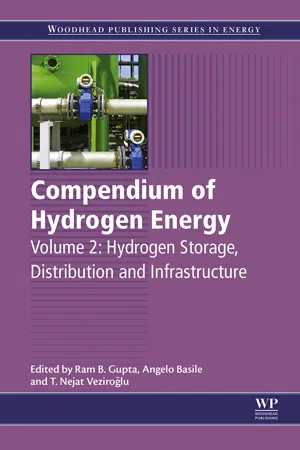
Compendium of Hydrogen Energy
Hydrogen Storage, Distribution and Infrastructure
- 438 pages
- English
- ePUB (mobile friendly)
- Available on iOS & Android
Compendium of Hydrogen Energy
Hydrogen Storage, Distribution and Infrastructure
About this book
Compendium of Hydrogen Energy, Volume 2: Hydrogen Storage, Distribution and Infrastructure focuses on the storage and transmission of hydrogen. As many experts believe the hydrogen economy will, at some point, replace the fossil fuel economy as the primary source of the world's energy, this book details hydrogen storage in pure form, including chapters on hydrogen liquefaction, slush production, as well as underground and pipeline storage.Other sections in the book explore physical and chemical storage, including environmentally sustainable methods of hydrogen production from water, with final chapters dedicated to hydrogen distribution and infrastructure.- Covers a wide array of methods for storing hydrogen, detailing hydrogen transport and the infrastructure required for transition to the hydrogen economy- Written by leading academics in the fields of sustainable energy and experts from the world of industry- Part of a very comprehensive compendium which looks at the entirety of the hydrogen energy economy
Frequently asked questions
- Essential is ideal for learners and professionals who enjoy exploring a wide range of subjects. Access the Essential Library with 800,000+ trusted titles and best-sellers across business, personal growth, and the humanities. Includes unlimited reading time and Standard Read Aloud voice.
- Complete: Perfect for advanced learners and researchers needing full, unrestricted access. Unlock 1.4M+ books across hundreds of subjects, including academic and specialized titles. The Complete Plan also includes advanced features like Premium Read Aloud and Research Assistant.
Please note we cannot support devices running on iOS 13 and Android 7 or earlier. Learn more about using the app.
Information
Introduction to hydrogen storage
2 Savannah River National Laboratory, Aiken, SC, USA
3 California Institute of Technology, Pasadena, CA, USA
Abstract
1.1 Introduction
Table of contents
- Cover image
- Title page
- Table of Contents
- Copyright
- List of contributors
- Woodhead Publishing Series in Energy
- Part One: Hydrogen storage in pure form
- Part Two: Physical and chemical storage of hydrogen
- Part Three: Hydrogen distribution and infrastructure
- Index